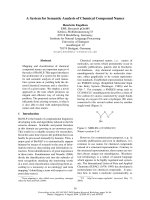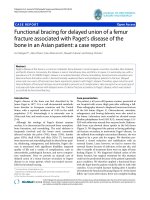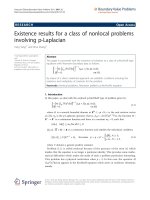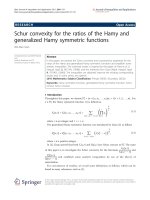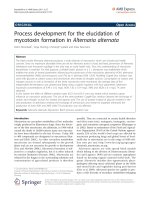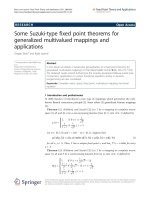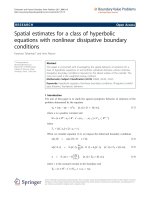Báo cáo hóa học: " CONVERGENCE THEOREMS FOR FIXED POINTS OF DEMICONTINUOUS PSEUDOCONTRACTIVE MAPPINGS" pdf
Bạn đang xem bản rút gọn của tài liệu. Xem và tải ngay bản đầy đủ của tài liệu tại đây (543 KB, 11 trang )
CONVERGENCE THEOREMS FOR FIXED POINTS OF
DEMICONTINUOUS PSEUDOCONTRACTIVE MAPPINGS
C. E. CHIDUME AND H. ZEGEYE
Received 26 August 2004
Let D be an open subset of a real uniformly smooth Banach space E.SupposeT :
¯
D →
E is a demicontinuous pseudocontractive mapping satisfying an appropriate condition,
where
¯
D denotes the closure of D. Then, it is proved that (i)
¯
D ⊆ (I + r(I −T)) for every
r>0; (ii) for a given y
0
∈ D, there exists a unique path t → y
t
∈
¯
D, t ∈ [0,1], satisfying
y
t
:= tT y
t
+(1−t)y
0
.Moreover,ifF(T) =∅or there exists y
0
∈ D such that the set
K :={y ∈ D : Ty= λy+(1−λ)y
0
for λ>1} is bounded, then it is proved that, as t →1
−
,
the path
{y
t
} converges strongly to a fixed point of T. Furthermore, explicit iteration
procedures with bounded error terms are proved to converge strongly to a fixed point
of T.
1. Introduction
Let D be a nonempty subset of a real linear space E.AmappingT : D
→ E is called
a contraction mapping if there exists L ∈ [0,1)suchthatTx −Ty≤Lx − y for all
x, y ∈D.IfL = 1thenT is called nonexpansive. T is called pseudocontractive if there exists
j(x − y) ∈J(x − y)suchthat
Tx−Ty, j(x − y)
≤x − y
2
, ∀x, y ∈K, (1.1)
where J is the normalized duality mapping from E to 2
E
∗
defined by
Jx :=
f
∗
∈ E
∗
:
x, f
∗
=
x
2
=
f
∗
2
. (1.2)
T is called strongly pseudocontractive if there exists k
∈ (0,1) such that
Tx−Ty, j(x − y)
≤ kx − y
2
, ∀x, y ∈K. (1.3)
Clearlytheclassofnonexpansivemappingsisasubsetofclassofpseudocontractivemap-
pings. T is said to be demicontinuous if
{x
n
}⊆D and x
n
→ x ∈ D together imply that
Tx
n
Tx,where→ and denote the strong and weak convergences, respectively. We
denote by F(T) the set of fixed points of T.
Copyright © 2005 Hindawi Publishing Corporation
Fixed Point Theory and Applications 2005:1 (2005) 67–77
DOI: 10.1155/FPTA.2005.67
68 Fixed points of demicontinuous pseudocontractive maps
Closely related to the class of pseudocontractive mappings is the class of accretive map-
pings. A mapping A : D(A) ⊆E → E is called accretive if T := (I −A) is pseudocontractive.
If E is a Hilbert space, accretive operators are also called monotone.AnoperatorA is called
m-accretive if it is accretive and (I + rA), the range of (I + rA), is E for all r>0; and A
is said to satisfy the range condition if cl(D(A)) ⊆( I + rA), for all r>0, where cl(D(A))
denotes the closure of the domain of A.
Let z ∈D,thenforeacht ∈(0,1), and for a nonexpansive map T, there exists a unique
point x
t
∈ D satisfying the condition,
x
t
= tTx
t
+(1−t)z (1.4)
since the mapping x → tTx +(1−t)z is a contraction. When E is a Hilbert space and T is
aself-map,Browder[1] showed that {x
t
} converges strongly to an element of F(T) which
is nearest to u as t →1
−
. This result was extended to various more general Banach spaces
by Reich [10], Takahashi and Ueda [11], and a host of other authors. Recently, Morales
and Jung [7] proved the existence and convergence of a continuous path to a fixed point
of a continuous pseudocontractive mapping in reflexive Banach spaces. More precisely,
they proved the following theorem.
Theorem 1.1 [7, Proposition 2(iv), Theorem 1]. Suppose D is a nonempty closed con-
vex subset of a reflexive Banach space E and T : D → E is a continuous pseudocontractive
mapping satisfying the weakly inward condition. Then for z ∈ D, there exists a unique path
t → y
t
∈ D, t ∈[0, 1), satisfying the following condition,
y
t
= tTy
t
+(1−t)z. (1.5)
Further more, suppose E is assumed to have a uniformly G
ˆ
ateaux differentiable norm and
is such that every closed convex and bounded subset of D has the fixed point propert y for
nonexpansive self-mappings. If F(T) =∅or there exists x
0
∈ D such that the set K :={x ∈
D : Tx =λx +(1−λ)x
0
for λ>1} is bounded, then as t →1
−
, the path converges strongly to
afixedpointofT.
From Theorem 1.1, one question arises quite naturally.
Question. Can the continuity of T be weakened to demicontinuity of T?
In connection with this, Lan and Wu [3] proved the following theorem in the Hilbert
space setting.
Theorem 1.2 [3, Theorems 2.3 and 2.5]. Le t E be a Hilbert space. Suppose D is a nonempty
closed convex subset of E and T : D
→ E is a demicontinuous pseudocontractive mapping
satisfying the weakly inward condit ion. Then for z ∈ D, there exists a unique path t → y
t
∈
D, t ∈(0,1), satisfying the following condition:
y
t
= tTy
t
+(1−t)z. (1.6)
Moreover, if (i) D is bounded then F(T) =∅and {y
t
} converges strongly to a fixed point
of T as t → 1
−
; (ii) D is unbounded and F(T) =∅then {y
t
} converges strongly to a fixed
point of T as t →1
−
.
C. E. Chidume and H. Zegeye 69
Let D be a nonempty open and convex subset of a real uniformly smooth Banach space
E.SupposeT :
¯
D →E is a demicontinuous pseudocontractive mapping which satisfies
for some z ∈D, Tx−z = λ(x −z)forx ∈∂D, λ>1, (1.7)
where
¯
D is the closure of D.
It is our purpose in this paper to give sufficient conditions to ensure that
¯
D
⊆ (I +
r(I −T))(
¯
D)foreveryr>0 and to prove the existence and convergence of a path to a
fixed point of a demicontinuous pseudocontractive mapping in spaces more general than
Hilbert spaces. More precisely, we prove that for a given y
0
∈ D, there exists a unique path
t → y
t
∈
¯
D, t ∈ (0,1), satisfying y
t
:= tTy
t
+(1−t)y
0
.Moreover,ifF(T) =∅or there ex-
ists y
0
∈ D such that the set K :={y ∈ D : Ty = λy +(1−λ)y
0
for λ>1} is bounded,
then the path {y
t
} converges strongly to a fixed point of T. Furthermore, the sequence
{x
n
} generated from x
1
∈ K by x
n+1
:= (1 −λ
n
)x
n
+ λ
n
Tx
n
−λ
n
θ
n
(x
n
−x
1
), for all integers
n
≥ 1, where {λ
n
} and {θ
n
} are real sequences satisfying appropriate conditions, con-
verges strongly to a fixed point of T.Ourtheoremsprovideanaffirmativeanswertothe
above question in uniformly smooth Banach spaces and extend Theorem 1.2 to uniformly
smooth spaces provided that the interior of D,int(D), is nonempty.
2. Preliminaries
Let E be a real normed linear space of dimension ≥ 2. The modulus of smoothness of E is
defined by
ρ
E
(τ):= sup
x + y+ x − y
2
−1:x=1, y=τ
, τ>0. (2.1)
If there exist a constant c>0 and a real number 1 <q<∞,suchthatρ
E
(τ) ≤ cτ
q
,then
E is said to be q-uniformly smooth. Typical examples of such spaces are L
p
and the Sobolev
spaces W
m
p
for 1<p<∞.ABanachspaceE is called uniformly smooth if lim
τ→0
(ρ
E
(τ)/τ) =
0. If E is a real uniformly smooth Banach space, then
x + y
2
≤x
2
+2
y, j(x)
+max
x,1
yb
y
(2.2)
holds for every x, y ∈ E where b :[0,∞) → [0,∞) is a continuous strictly increasing func-
tion satisfying the following conditions:
(i) b(ct)
≤ cb(t), ∀c ≥1,
(ii) lim
t→0
b(t) =0. (See, e.g., [8].)
Let D beanonemptysubsetofaBanachspaceE.Forx ∈D,theinward set of x, I
D
(x),
is defined by I
D
(x):={x + λ(u −x):u ∈D, λ ≥1}.AmappingT : D → E is called weakly
inward if Tx ∈cl[I
D
(x)] for all x ∈ D,wherecl[I
D
(x)] denotes the closure of the inward
set. Every self-map is trivially weakly inward.
Let D ⊆ E be closed convex and let Q be a mapping of E onto D.AmappingQ of E
into E is said to be a retraction if Q
2
= Q.IfamappingQ is a retraction, then Qz =z for
every z ∈ R(Q), range of Q.AsubsetD of E is said to be a nonexpansive ret ract of E if
there exists a nonexpansive retraction of E onto D. If E = H, the metric projection P
D
is a
nonexpansive retraction from H to any closed convex subset D of H.
70 Fixed points of demicontinuous pseudocontractive maps
In what follows, we will make use of the following lemma and theorems.
Lemma 2.1 [2]. Let {λ
n
}, {γ
n
},and{α
n
} be sequences of nonnegative numbers satisfying
∞
1
α
n
=∞and γ
n
/α
n
→ 0,asn →∞. Let the recursive inequality
λ
n+1
≤ λ
n
−2α
n
ψ
λ
n
+ γ
n
, n =1,2, , (2.3)
be given where ψ :[0,∞) → [0,∞) is a nondecreasing function such that it is positive on
(0,∞) and ψ(0) =0. Then λ
n
→ 0,asn →∞.
Theorem 2.2 [6]. Let E be a uniformly smooth Banach space and let D be an open subset
of E.SupposeT :
¯
D → E is a demicontinuous strongly pseudocontractive mapping which
satisfies
for some z ∈ D : Tx−z = λ(x −z) for x ∈∂D, λ>1. (2.4)
Then T has a unique fixed point in
¯
D.
Remark 2.3. We observe that, in Theorem 2.2, if, in addition, D is convex, then any weakly
inward map satisfies condition (2.4).
Theorem 2.4 (Reich [10]). Let E be uniformly smooth. Let A ⊂ E ×E be accretive with
cl(D(A)) convex. Suppose A satisfies the range condition. Le t J
t
:= (I + tA)
−1
, t>0 be the
resolvent of A and assume that A
−1
(0) is nonempty. Then, for each x ∈ (I + rA)(
¯
D),
lim
t→∞
J
t
x = Px ∈A
−1
(0),whereP is the sunny nonexpansive retraction of cl(D(A)) onto
A
−1
(0).
Remark 2.5. Fr om the proof of Theorem 2.4, we observe that we may replace the as-
sumption that A
−1
(0) =∅with the assumption that x
t
= J
t
x is bounded, for each x ∈
(I + tA)andt>0.
3. Main results
We first prove the following results which will be used in the sequel.
Proposition 3.1. Let D be an open subset of a real uniformly smooth Banach space E
and let T :
¯
D
→ E be a demicontinuous pseudocontractive mapping which satisfies condition
(2.4). Let A
T
:
¯
D →E be defined by A
T
:= I + r(I −T) for any r>0. Then
¯
D ⊆A
T
[
¯
D].
Proof. Let z ∈
¯
D.Thenitsuffices to show that there exists x ∈
¯
D such that z = A
T
(x).
Define g :
¯
D → E by g(x):= (1/(1 + r))(rT(x)+z)forsomer>0. Then clearly g is demi-
continuous and for x, y ∈
¯
D we have that g(x) −g(y), j(x − y)≤(r/(1 + r))x − y
2
.
Thus, g is a strongly pseudocontractive mapping which satisfies condition (2.4). There-
fore, by Theorem 2.2, there exists x ∈
¯
D such that g(x) =x, that is, z = A
T
(x). The proof
is complete.
Corollary 3.2. Le t E be a real uniformly smooth Banach space and let A : E →E be demi-
continuous accretive mapping. Then A is m-accretive.
C. E. Chidume and H. Zegeye 71
Proof. Set T := (I −A). Then, we obtain that T is a demicontinuous pseudocontractive
self-map of E. Clearly, condition (2.4) is satisfied. The conclusion follows from
Proposition 3.1.
Corollary 3.2 was proved by Minty [5] in a Hilbert space setting for continuous accre-
tive mappings and this was extended to general Banach spaces by Martin [4].
We now prove the following theorems.
Theorem 3.3. Let D be an open and convex subset of a real uniformly smooth Banach space
E.LetT :
¯
D →E be a demicontinuous pseudocontractive mapping satisfying condition (2.4).
Then for a given y
0
∈ D, there exists a unique path t → y
t
∈
¯
D, t ∈(0,1), satisfy ing
y
t
= tTy
t
+(1−t)y
0
. (3.1)
Furthermore, if F(T) =∅or there exists z ∈ D such that the set K :={y ∈ D : Ty= λy +
(1 −λ)z for λ>1} is bounded, then the path {y
t
} described by (3.1) converges strongly to a
fixed point of T as t →1
−
.
Proof. For each t ∈ (0,1) the mapping T
t
defined by T
t
x := tT(t
n
)x +(1−t)y
0
is demi-
continuous and strongly pseudocontractive. By Theorem 2.2, it has a unique fixed point
y
t
in
¯
D, that is, for each t ∈(0,1) there exists y
t
∈
¯
D satisfying (3.1). Continuity of y
t
fol-
lows as in [7]. Now we show the convergence of {y
t
} to a fixed point of T.LetA :=I −T.
Then A is accretive and by Proposition 3.1,
¯
D ⊆(I + rA)(
¯
D)forallr>0 and hence A sat-
isfies the range condition. Moreover, from (3.1), y
t
+(t/(1 −t))Ay
t
= y
0
. But this implies
that y
t
= (I +(t/(1 −t))A)
−1
y
0
= J
(t/(1−t))
y
0
. Furthermore, since A
−1
(0) =∅or the fact
that K is bounded implies that {y
t
} is bounded (see, e.g., [7]), we have by Theorem 2.4
that y
t
→ y
∗
∈ A
−1
(0) and hence y
t
→ y
∗
∈ F(T)ast → 1
−
. This completes the proof of
the theorem.
Remark 3.4. We note that, in Theorem 3.3, the requirement that T satisfies condition
(2.4) may be replaced with the weakly inward condition. Fur thermore, Theorem 3.3
extends [3, Theorems 2.3 and 2.5] to the more general Banach spaces which include
l
p
,L
p
,W
m
p
,1 <p<∞, spaces, provided that int(D)isnonempty.
For our next theorem and corollary, {λ
n
}, {θ
n
},and{c
n
} are real sequences in [0,1]
satisfying the following conditions:
(i) lim
n→∞
θ
n
= 0;
(ii)
∞
n=1
λ
n
θ
n
=∞,lim
n→∞
(b(λ
n
)/θ
n
) =0;
(iii) lim
n→∞
((θ
n−1
/θ
n
−1)/λ
n
θ
n
) =0, c
n
= o(λ
n
θ
n
).
Theorem 3.5. Let D be an open and convex subset of a real uniformly smooth Banach space
E.SupposeT :
¯
D → E is a bounded demicontinuous pseudocontractive mapping satisfying
condition (2.4). Suppose
¯
D is a nonexpansive re tract of E with Q as the nonexpansive retrac-
tion. Let a sequence {x
n
} be generated from x
0
∈ E by
x
n+1
= Q
1 −λ
n
x
n
+ λ
n
Tx
n
−λ
n
θ
n
x
n
−x
0
−c
n
x
n
−u
n
, (3.2)
72 Fixed points of demicontinuous pseudocontractive maps
for all positive integers n,where{u
n
}is a sequence of bounded error terms. If either F(T) =∅
or the set K :={x ∈ D : Tx = λx +(1−λ)x
0
for λ>1} is bounded, then there exists d>0
such that whenever λ
n
≤ d and c
n
/λ
n
θ
n
,b(λ
n
)/θ
n
≤ d
2
for all n ≥0, {x
n
} converges strongly
to a fixed point of T.
Proof. By Theorem 3.3, F(T) =∅.Letx
∗
∈ F(T). Let r>1besufficiently large such that
x
0
∈ B
r/2
(x
∗
).
Claim 3.6. {x
n
} is bounded.
It suffices to show by induction that {x
n
} belongs to B = B
r
(x
∗
) for all positive inte-
gers. Now, x
0
∈ B by assumption. Hence we may assume that x
n
∈ B and set M := 2r +
sup{(I −T)x
i
+ x
i
−u
i
,fori ≤n}.Weprovethatx
n+1
∈ B.Supposex
n+1
is not in B.
Then
x
n+1
−x
∗
>rand thus from (3.2)wehavethatx
n+1
−x
∗
≤x
n
−x
∗
−λ
n
((I −
T)x
n
+ θ
n
(x
n
−x
0
))−c
n
(x
n
−u
n
)≤x
n
−x
∗
+ λ
n
(I −T)x
n
+ θ
n
(x
n
−x
0
)+(c
n
/λ
n
)(x
n
−
u
n
)≤r + M. Moreover, from (3.2) and inequality (2.2), and using the fact that θ
n
≤ 1,
we get that
x
n+1
−x
∗
2
=
Q
1 −λ
n
x
n
+ λ
n
Tx
n
−λ
n
θ
n
x
n
−x
0
−c
n
x
n
−u
n
−x
∗
≤
x
n
−x
∗
−λ
n
(I −T)x
n
+ θ
n
x
n
−x
0
−c
n
(x
n
−u
n
)
2
≤
x
n
−x
∗
2
−2λ
n
(I −T)x
n
, j
x
n
−x
∗
−2λ
n
θ
n
x
n
−x
0
, j
x
n
−x
∗
−2c
n
x
n
−u
n
, j
x
n
−x
∗
+max
x
n
−x
∗
,1
λ
n
(I −T)x
n
+ θ
n
x
n
−x
0
+
c
n
λ
n
x
n
−u
n
×b
λ
n
(I −T)x
n
+ θ
n
x
n
−x
0
+
c
n
λ
n
x
n
−u
n
≤
x
n
−x
∗
2
−2λ
n
(I −T)x
n
, j
x
n
−x
∗
−2λ
n
θ
n
x
n
−x
0
, j
x
n
−x
∗
−2c
n
x
n
−u
n
, j
x
n
−x
∗
+(r +1)λ
n
Mb
λ
n
M
.
(3.3)
Since T is pseudocontractive and x
∗
∈ F(T), we have (I −T)x
n
, j(x
n
−x
∗
)≥0. Hence
(3.3)gives
x
n+1
−x
∗
2
≤
x
n
−x
∗
2
−2λ
n
θ
n
x
n
−x
0
, j
x
n
−x
∗
+2c
n
x
n
−u
n
·
x
n
−x
∗
+(r +1)λ
n
M
2
b
λ
n
.
(3.4)
Choose L>0sufficiently small such that L
≤ r
2
/(2
√
D
∗
+2M)
2
,whereD
∗
= (r +1)M
2
.
Set d :=
√
L. Then since x
n+1
−x
∗
> x
n
−x
∗
by our assumption, from (3.4)weget
that 2λ
n
θ
n
x
n
−x
0
, j(x
n
−x
∗
)≤(r +1)M
2
λ
n
b(λ
n
)+2c
n
Mr which gives x
n
−x
0
, j(x
n
−
x
∗
)≤D
∗
L, since c
n
/λ
n
θ
n
,b(λ
n
)/θ
n
≤ L = d
2
,foralln ≥ 1 by our assumption.
C. E. Chidume and H. Zegeye 73
Now adding x
0
−x
∗
, j(x
n
−x
∗
) to both sides of this inequality, we get that
x
n
−x
∗
2
≤ LD
∗
+
x
0
−x
∗
, j
x
n
−x
∗
≤ LD
∗
+
x
0
−x
∗
x
n
−x
∗
≤ LD
∗
+
r
2
x
n
−x
∗
.
(3.5)
Solving this quadratic inequality for x
n
−x
∗
and using the estimate
√
r
2
/16 + LD
∗
≤
r/4+
√
LD
∗
,weobtainthatx
n
−x
∗
≤r/2+
√
LD
∗
. But in any case, x
n+1
−x
∗
≤
x
n
−x
∗
+ λ
n
(I −T)x
n
+ θ
n
(x
n
−x
0
)+(c
n
/λ
n
)(x
n
−u
n
) so that x
n+1
−x
∗
≤r/2+
√
LD
∗
+ λ
n
M ≤ r, by the original choices of L and λ
n
, and this contradicts the assumption
that x
n+1
is not in B. Therefore, x
n
∈ B for all positive integers n.Thus{x
n
} is bounded.
Now we show that x
n
→ x
∗
.Let{y
n
} be a subsequence of {y
t
: t ∈[0,1)},suchthaty
n
:=
y
t
n
, t
n
= 1/(1 + θ
n
). Then from (3.2) and inequality (2.2) and using the fact that y
n
∈
¯
D
for all n ≥0, we get
x
n+1
− y
n
2
=
Q
1 −λ
n
x
n
+ λ
n
Tx
n
−λ
n
θ
n
x
n
−x
0
−c
n
x
n
−u
n
− y
n
2
≤
x
n
− y
n
−λ
n
(I −T)x
n
+ θ
n
x
n
−x
0
−c
n
x
n
−u
n
2
≤
x
n
− y
n
2
−2λ
n
(I −T)x
n
+ θ
n
x
n
−x
0
, j
x
n
− y
n
−2c
n
x
n
−u
n
, j
x
n
− y
n
+max
x
n
− y
n
,1
λ
n
(I −T)x
n
+ θ
n
x
n
−x
0
+
c
n
λ
n
x
n
−u
n
×b
λ
n
(I −T)x
n
+ θ
n
x
n
−x
0
+
c
n
λ
n
x
n
−u
n
≤
1 −2λ
n
θ
n
x
n
− y
n
2
−2λ
n
(I −T)x
n
+ θ
n
y
n
−x
0
, j
x
n
− y
n
+2c
n
x
n
−u
n
·
x
n
− y
n
+max
x
n
− y
n
,1
λ
n
(I −T)x
n
+ θ
n
x
n
−x
0
+
c
n
λ
n
x
n
−u
n
×
b
λ
n
(I −T)x
n
+ θ
n
x
n
−x
0
+
c
n
λ
n
x
n
−u
n
.
(3.6)
Since Ty
n
= y
n
+ θ
n
(y
n
−x
0
)andT is pseudocontractive, we get that (I −T)x
n
+ θ
n
(y
n
−
x
0
), j(x
n
− y
n
)≥0. Moreover, since {x
n
}, {y
n
}, and hence {Tx
n
}, are bounded, there ex-
ists M
0
> 0 such that max {x
n
− y
n
,1,x
n
− y
n
·x
n
−u
n
,(I −T)x
n
+ θ
n
(x
n
−x
0
)+
(c
n
/λ
n
)(x
n
−u
n
)} ≤M
0
. Therefore, (3.6)withpropertyofb gives
x
n+1
− y
n
2
≤
1 −2λ
n
θ
n
x
n
− y
n
2
+ M
0
λ
n
b
λ
n
+ c
n
M
0
. (3.7)
On the other hand, by the pseudocontractivity of T and the fact that θ
n
(y
n
−x
0
)+(y
n
−
Ty
n
) =0, we have that
y
n−1
− y
n
≤
y
n−1
− y
n
+
1
θ
n
(I −T)y
n−1
−(I −T)y
n
≤
θ
n−1
−θ
n
θ
n
y
n−1
+ z
=
θ
n−1
θ
n
−1
y
n−1
+ z
.
(3.8)
74 Fixed points of demicontinuous pseudocontractive maps
However,
x
n
− y
n
2
≤
x
n
− y
n−1
2
+
y
n−1
− y
n
y
n−1
− y
n
+2
y
n−1
−x
n
. (3.9)
Therefore, these estimates with (3.7)givethat
x
n+1
− y
n
2
≤
1 −2λ
n
θ
n
x
n
− y
n−1
2
+ M
1
θ
n−1
θ
n
−1
+ M
1
λ
n
b
λ
n
+ c
n
M
1
, (3.10)
for some M
1
> 0. Thus, by Lemma 2.1, x
n+1
− y
n
→ 0. Hence, since y
n
→ x
∗
by Theorem
3.3,wehavethatx
n
→ x
∗
, this completes the proof of the theorem.
With the help of Remark 2.3 and Theorem 3.5 we obtain the following corollary.
Corollary 3.7. Let D be an ope n and convex subset of a real uniformly smooth Banach
space E.SupposeT :
¯
D → E is a bounded demicontinuous pseudocontractive mapping satis-
fy ing the weakly inward condition. Suppose
¯
D is a nonexpansive retract of E with Q as the
nonexpansive retraction. Let a sequence {x
n
} be generated from x
0
∈E by
x
n+1
= Q
1 −λ
n
x
n
+ λ
n
Tx
n
−λ
n
θ
n
x
n
−x
0
−c
n
x
n
−u
n
, (3.11)
for all positive integers n,where{u
n
} isasequenceoferrorterms.IfeitherF(T) =∅or the
set K :={x ∈D : Tx = λx +(1−λ)x
0
for λ>1} is bounded then, there exists d>0 such that
whenever λ
n
≤ d and c
n
/λ
n
θ
n
,b(λ
n
)/θ
n
≤ d
2
for all n ≥0, {x
n
} converges strongly to a fixed
point of T.
Remark 3.8. For the case where E is q-uniformly smooth, where q>1, and t ≤ M for
some M>0, the function b in (2.2)isestimatedbyb(t) ≤ct
q−1
for some c>0 (see [9]).
Thus, we have the following corollary.
Corollary 3.9. Let D be an open and convex subs et of a real q-uniformly smooth Banach
space E.SupposeT :
¯
D
→ E is a bounded demicontinuous pseudocontractive mapping satis-
fy ing condition (2.4). Suppose
¯
D is a nonexpansive retract of E with Q as the nonexpansive
retraction and let {λ
n
}, {θ
n
},and{c
n
} be real sequences in (0,1] satisfying the following
conditions:
(i) lim
n→∞
θ
n
= 0;
(ii)
∞
n=1
λ
n
θ
n
=∞, lim
n→∞
(λ
(q−1)
n
/θ
n
) =0;
(iii) lim
n→∞
((θ
n−1
/θ
n
−1)/λ
n
θ
n
) =0, c
n
= o(λ
n
θ
n
).
Let a sequence {x
n
} be generated from x
0
∈ E by
x
n+1
= Q
1 −λ
n
x
n
+ λ
n
Tx
n
−λ
n
θ
n
x
n
−x
0
−c
n
x
n
−u
n
, (3.12)
for all positive integers n,where{u
n
}is a bounded sequence of error terms. If either F(T) =∅
or the set K :={x ∈ D : Tx = λx +(1−λ)x
0
for λ>1} is bounded, then there exists d>0
such that whenever λ
n
≤ d and c
n
/λ
n
θ
n
,λ
(q−1)
n
/θ
n
≤ d
2
for all n ≥0, {x
n
} converges strongly
to a fixed point of T.
C. E. Chidume and H. Zegeye 75
Remark 3.10. Examples of sequences {λ
n
} and {θ
n
} satisfying conditions of Corollary 3.9
are as follows: λ
n
= 2(n +1)
−a
, θ
n
= 2(n +1)
−b
,andc
n
= 2(n +1)
−1
with 0 <b<aand
a + b<1if2≤q<∞, and with 0 <b<a(q −1) and a + b(q −1) < 1if1<q<2.
If in Theorem 3.5, T is a self-map of
¯
D, then the projection operator Q is replaced with
I, the identity map on E.Moreover,T satisfies condition (2.4). As a consequence, we have
the following corollaries.
Corollary 3.11. Let D be an open and convex subset of a real uniformly smooth Ba-
nach space E.SupposeT :
¯
D →
¯
D is a bounded demicontinuous pseudocontractive mapping.
Suppose {λ
n
}, {θ
n
},and{c
n
} are real seque nces in (0, 1] satisfying conditions (i)–(iii) of
Theorem 3.5 and λ
n
(1 + θ
n
)+c
n
≤ 1, ∀n ≥0.Letasequence{x
n
} be generated from x
0
∈E
by
x
n+1
=
1 −λ
n
x
n
+ λ
n
Tx
n
−λ
n
θ
n
x
n
−x
0
−c
n
x
n
−u
n
, (3.13)
for all positive integers n,where{u
n
}is a sequence of bounded error terms. If either F(T) =∅
or the set K :={x ∈ D : Tx = λx +(1−λ)x
0
for λ>1} is bounded, then there exists d>0
such that whenever λ
n
≤ d and c
n
/λ
n
θ
n
,b(λ
n
)/θ
n
≤ d
2
for all n ≥0, {x
n
} converges strongly
to a fixed point of T.
Proof. The conditions on λ
n
, θ
n
,andc
n
imply that the sequence {x
n
} is well defined.
Thus, the proof follows from Theorem 3.5.
If in Theorem 3.5, D is assumed to be b ounded, then the conditions λ
n
≤ d and
c
n
/λ
n
θ
n
,b(λ
n
)/θ
n
≤ d
2
for some d>0 which guarantee the boundedness of the sequence
{x
n
} are not needed. In fact, we have the following corollary.
Corollary 3.12. Let D be an open convex and bounded subset of a real uniformly smooth
Banach space E.SupposeT :
¯
D → E is a bounded demicontinuous pseudocontractive map-
ping satisfying the weakly inward condition. Suppose
¯
D is a nonexpansive retract of E with
Q as the nonexpansive retraction and let {λ
n
}, {θ
n
},and{c
n
} be real sequences in (0,1)
satisfying conditions (i)–(iii) of Theorem 3.5.Letasequence{x
n
} be generated from x
0
∈ E
by
x
n+1
= Q
1 −λ
n
x
n
+ λ
n
Tx
n
−λ
n
θ
n
x
n
−x
0
−c
n
x
n
−u
n
, (3.14)
for all positive integers n,where{u
n
} isasequenceoferrorterms.Then{x
n
} converges
strongly to a fixed point of T.
Proof. Since D, and hence
¯
D, is bounded we have that {x
n
} is bounded. Thus the conclu-
sion follows from Theorem 3.5.
Corollary 3.13. Let D be an open convex and bounded subset of a real uniformly smooth
Banach space E.SupposeT :
¯
D →
¯
D is a bounded demicontinuous pseudocontractive map-
ping. Let {λ
n
}, {θ
n
},and{c
n
} be real sequences in (0, 1] satisfying conditions (i)–(iii) of
Theorem 3.5 and λ
n
(1 + θ
n
)+c
n
≤ 1, ∀n ≥0.Letasequence{x
n
} be generated from x
0
∈E
76 Fixed points of demicontinuous pseudocontractive maps
by
x
n+1
=
1 −λ
n
x
n
+ λ
n
Tx
n
−λ
n
θ
n
x
n
−x
0
−c
n
x
n
−u
n
, (3.15)
for all positive integers n,where{u
n
} isasequenceoferrorterms.Then{x
n
} converges
strongly to a fixed point of T.
Remark 3.14. If in Theorem 3.5, D is bounded, T is a self-map, and c
n
≡ 1foralln ≥1,
that is, the error term is ignored, then the following corollary holds.
Corollary 3.15. Let D be an open convex and bounded subset of a real uniformly smooth
Banach space E.SupposeT :
¯
D →
¯
D is a bounded demicontinuous pseudocontractive map-
ping. Let {λ
n
} and {θ
n
} be real sequences in (0,1] satisfying conditions (i)–(iii) of Theorem
3.5 with c
n
≡ 0 for all n ≥1 and λ
n
(1 + θ
n
) ≤1,foralln ≥ 0.Letasequence{x
n
} be gener-
ated from x
0
∈ E by
x
n+1
=
1 −λ
n
x
n
+ λ
n
Tx
n
−λ
n
θ
n
x
n
−x
0
, (3.16)
for all positive integers n. Then {x
n
} converges strongly to a fixed point of T.
The following convergence theorem is for the approximation of solution of demicon-
tinuous accretive mappings.
Theorem 3.16. Let D be an open and convex subset of a real uniformly smooth Banach
space E.SupposeA :
¯
D
→ E is a bounded demicontinuous accretive mapping which satisfies,
for some x
0
∈ D, Ax =t(x −x
0
) for all x ∈ ∂D and t<0.Suppose
¯
D is a nonexpansive retract
of E with Q as the nonexpansive retraction and let {λ
n
}, {θ
n
},and{c
n
} be real sequences in
(0,1] satisfying conditions (i)–(iii) of Theorem 3.5.Letasequence{x
n
} be generated from
x
0
∈ E by
x
n+1
= Q
x
n
−λ
n
Ax
n
+ θ
n
x
n
−x
0
−c
n
x
n
−u
n
, (3.17)
for all positive integers n,where{u
n
} is a s equence of bounded error ter ms. Suppose ei-
ther N(A) =∅(N(A) is the null space of A)or the set K :={x ∈ D :(I − A)x = λx +
(1 −λ)x
0
for λ>1} is bounded. Then there exists d>0 such that whenever λ
n
≤ d and
c
n
/λ
n
θ
n
,b(λ
n
)/θ
n
≤ d
2
for all n ≥0, {x
n
} converges strongly to a zero of A.
Proof. Set T := (I −A). Then, we have that for some x
0
∈ D,(I − T)x = t(x −x
0
)for
x ∈∂D and t<0. This implies that Tx−x
0
= λ(x −x
0
)forallx ∈∂D and λ>1. Moreover,
F(T) =∅or the set K ={x ∈ D : Tx = λx +(1−λ)x
0
,forλ = (1 −t) > 1} is bounded.
Therefore, by Theorem 3.5, {x
n
} converges strongly to x
∗
∈ F(T). But F(T) = N(A).
Hence, {x
n
} converges strongly to x
∗
∈ N(A). The proof of the theorem is complete.
The following corollary follows from Theorem 3.16.
Corollary 3.17. Let E be a real uniformly smooth Banach space and suppose A : E → E is
a bounded demicontinuous accretive mapping. Let {λ
n
}, {θ
n
},and{c
n
} be real sequences in
(0,1] satisfying conditions (i)–(iii) of Theorem 3.5.Letasequence{x
n
} be generated from
C. E. Chidume and H. Zegeye 77
x
0
∈ E by
x
n+1
= x
n
−λ
n
Ax
n
+ θ
n
x
n
−x
0
−c
n
x
n
−u
n
, (3.18)
for all positive integers n,where
{u
n
} isasequenceofboundederrorterms.IfeitherN(A) =
∅ or the set K :={x ∈ E :(I −A)x = λx +(1−λ)x
0
for λ>1} is bounded, then there exists
d>0 such that whenever λ
n
≤ d and c
n
/λ
n
θ
n
,b(λ
n
)/θ
n
≤ d
2
for all n ≥ 0, {x
n
} converges
strongly to a point of N(A).
Acknowledgment
The second author undertook this work when he was visiting The Abdus Salam Interna-
tional Centre for Theoretical Physics, Trieste, Italy, as a Junior Associate.
References
[1] F.E.Browder,Convergence of approximants to fixed points of nonexpansive non-linear mappings
in Banach spaces, Arch. Rational Mech. Anal. 24 (1967), 82–90.
[2] C. E. Chidume and H. Zegeye, Approximation of solutions of nonlinear equations of monotone
and Hammer s tein type,Appl.Anal.82 (2003), no. 8, 747–758.
[3] K.Q.LanandJ.H.Wu,Conver gence of approximants for demicontinuous pseudo-contractive
maps in Hilbert spaces , Nonlinear Anal. Ser. A: Theory Methods 49 (2002), no. 6, 737–746.
[4] R. H. Mar tin Jr., A global existence theorem for autonomous differential equations in a Banach
space,Proc.Amer.Math.Soc.26 (1970), 307–314.
[5] G.J.Minty,Monotone (nonlinear) operators in Hilbert space, Duke Math. J. 29 (1962), 341–346.
[6] C.H.Morales,Zeros for accretive operators satisfying certain boundary conditions, J. Math. Anal.
Appl. 105 (1985), no. 1, 167–175.
[7] C.H.MoralesandJ.S.Jung,Convergence of paths for pseudocontractive mappings in Banach
spaces,Proc.Amer.Math.Soc.128 (2000), no. 11, 3411–3419.
[8] S. Reich, An iterative procedure for constructing zeros of accretive sets in Banach spaces, Nonlinear
Anal. 2 (1978), no. 1, 85–92.
[9]
, Constructive techniques for accretive and monotone operators, Applied Nonlinear Anal-
ysis (Proc. Third Internat. Conf., Univ. Texas, Arlington, Tex., 1978), Academic Press, New
York, 1979, pp. 335–345.
[10]
, Strong conver gence theorems for resolvents of accretive operators in Banach spaces,J.
Math. Anal. Appl. 75 (1980), no. 1, 287–292.
[11] W. Takahashi and Y. Ueda, On Reich’s strong convergence theorems for resolvents of accretive
operators,J.Math.Anal.Appl.104 (1984), no. 2, 546–553.
C. E. Chidume: The Abdus Salam International Centre for Theoretical Physics, 34014 Trieste, Italy
E-mail address:
H. Zegeye: The Abdus Salam International Centre for Theoretical Physics, 34014 Trieste, Italy
E-mail address:
